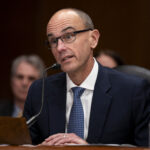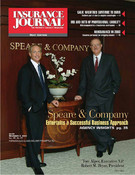The second ever bi-annual conference of the Federation of European Risk Management Associations (FERMA), held Oct. 5 – 8 in Rome, Italy, featured presenters and workshops that highlighted both the similarities and the differences between the U.S. and the European approach to risk management.
FERMA is an umbrella group composed of representatives of the risk management associations of the U.K., the Netherlands, Italy, Spain, France, Germany, Belgium, Switzerland and Denmark.
President Thierry van Santen, the director of risk management for France’s Group Danone, represents the French risk management association AMRAE. He opened the conference with provocative remarks that the goal of risk management is not to obtain certainty, as “certainty is the enemy of opportunity.”
Discussions and presentations centered around some familiar topics—lack of capacity in certain markets, the increasingly important role the rating agencies play in selecting coverage, corporate governance, the ever present problem of the insurance cycle, and somewhat ominously, the growth of the “compensation culture,” i.e. civil lawsuits à la Américane, in Europe. These themes recurred throughout the proceedings, and would be familiar to most American risk managers and insurance professionals.
Some of the most knowledgeable comments came from Steve A. Schleisman, an American who heads Allianz Global Risks. He put the blame for the swings in pricing that are the main component of the cycle squarely on management. “It would be wrong to look at underwriters as controlling pricing. The underwriter prices the individual transaction,” he said. “The buck has to stop with management; the brokers aren’t responsible for it either.”
“Cycles aren’t even,” Schleisman observed. “Some markets go up while others go down, but as more information becomes available—better reporting, better controls—it will moderate the cycle, and should result in ‘softer’ cycles.”
He also sees the rating agencies in a more positive light than many insurers do, noting that they “have an emerging global role as a moderating force, restraining excessive behavior.”
He was also brutally honest about why Allianz, along with most other insurers, had raised premiums so dramatically; “we were bleeding to death, and we had to clean up our act. My first goal was survival.” It was hard for anyone to argue with that, even if it indicates that risk managers are going to be paying more for coverage into the foreseeable future.
While those concerns would also be familiar topics in the U.S., it’s highly unlikely that a RIMS conference would focus as much on “corporate social responsibility” (CSR) as FERMA did. Practically every presentation included it as a bona fide concern for risk managers to consider. It’s even less likely that RIMS would be addressed by labor leader Nicole Notat, or by such an outspoken critic of the developed world’s domination of the earth’s resources at the expense of the world’s poor—2.7 billion of whom live on $2.00 a day or less—as Professor Riccardo Petrella of the Catholic University of Louvain.
Notat, the former head of the Conféderation Française Democratique du Travail, one of the country’s biggest labor unions, has earned a deserved reputation in France for her independence. She actually tried to make some progress in moderating managements’ demands, workers’ needs and economic sense. In the course of which, at one point or another, she was pilloried by all sides, indicating that she must have been doing something right. She now heads VIGEO, an independent company that issues ratings on the social and environmental performance of companies.
Addressing the delegates in French, she observed, “Companies are increasingly aware of the need for transparency. They realize that credibility is an asset, and that companies that don’t communicate, or who hide unpleasant facts, ultimately run a greater risk to their business than if they had disclosed them in the first place.” No one really disagreed with that idea either.
A lot of people, however, might well disagree with Professor Petrella’s blunt rejection of the idea that a market economy provides an ideal model for development. “The current strong emphasis on privatization requires that everything be turned into a commodity,” he said. He charged the audience to look beyond profits if it wanted to address environmental, social and terrorist problems. As an example, he asserted that “everyone in the world could have clean water within 10 years, at a cost of around $180 billion. A lot of money, but less than the $347 billion spent on agricultural subsidies each year, less than the $204 billion spent annually on advertising.” He added, “We should declare poverty illegal.”
Having suffered heavily from the wars of the 20th century, Europeans seem to see the world in a different light than Americans—a world once more dangerous in terms of risks, but at the same time better prepared to deal with them due to the existence of governmental protection mechanisms. Basically Europeans look more to national and international bodies to sort out problems than Americans do.
All the “usual suspects” were in attendance—the world’s five largest brokers plus Assurex, most of its leading insurers, and a number of the leaders in security, risk assessment, prevention and mitigation.
Nick Maher, chairman of Aon’s Global Practice Group observed in a company press release that the more conservative attitude in Europe, which he attributed to “cultural differences,” was keeping many companies from considering “alternative, less conservative programming structures that may involve higher levels of self-insurance.”
Forum Chairman Roberto Bosco, the Group Risk Manager of Italy’s Mediaset, highlighted the discrepancies between Europe’s approach to risk management and that of the U.S. He noted that only about six percent of Italian companies even have risk managers. While the percentages are higher in other countries, notably the U.K. and the Netherlands, the number doesn’t come close to the 80 percent of U.S. companies that have risk management departments.
Marsh presented a new study, the first of its kind, which surveyed 4,300 different companies in a number of industries to determine which ones had the most coverage, their limits and their potential risk exposures. Unsurprisingly, the Marsh study also stressed the growing apprehension in Europe that the “compensation culture,” born in the U.S.A., seems to be spreading across the Atlantic. Although many European companies who do business in the U.S. have long been aware of the legal minefield it represents, until now Europe had been seen as safe from multi-million dollar judgments, class actions and frivolous lawsuits. That may be changing.
In the final presentation of the conference, Lloyd’s CEO Nick Prettejohn made a similar point. He also made a strong, and by now familiar, pitch to the industry to try and stop, or at least mitigate the hard/soft market cycle that continually erodes profits and capital. He was one of the few speakers who did not address CSR issues, perhaps reflecting the fact that Lloyd’s focus is somewhat different than its counterparts in Europe.
Finally, a special mention should be given to XL Capital, who welcomed a large number of those attending the conference to a truly luxurious reception on the roof of the Capitoline museum, complete with a guided tour of the finest collection of Roman antiquities in the world.
To comment on this story, e-mail: cboyle@insurancejournal.com.
Topics USA Europe Training Development France
Was this article valuable?
Here are more articles you may enjoy.


 Florida Jury Returns $779M Verdict for Family of Security Guard Killed at Gambling Cafe
Florida Jury Returns $779M Verdict for Family of Security Guard Killed at Gambling Cafe  McKinsey Plots Thousands of Job Cuts in Slowdown for Consulting Industry
McKinsey Plots Thousands of Job Cuts in Slowdown for Consulting Industry  Chubb, The Hartford, Liberty and Travelers Team Up on Surety Tech Launch
Chubb, The Hartford, Liberty and Travelers Team Up on Surety Tech Launch  One of Highest Property Claims Severity Recorded in Q3 on Low Volume, Says Verisk
One of Highest Property Claims Severity Recorded in Q3 on Low Volume, Says Verisk 


